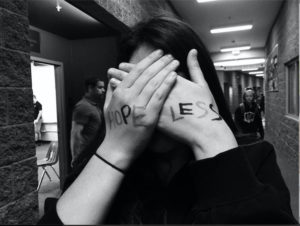Understanding and Preventing Youth Suicide

This week’s blog will be focusing on a hard but real topic we must all realize is preventable if we follow the warning signs: Suicide.

Specifically, suicide in young adults and adolescents. If you haven’t heard about Markeice “Mari” Brown & Mercedes Shaday Smith, they are a young couple who committed suicide a week ago only a couple days apart. Unfortunately, stories like theirs are popping up on our social media feeds and the news more and more.
Suicide is the second leading cause of death among teens and adolescents. One thing that is forgotten or not understood is that suicide is preventable. “Youths who are contemplating suicide frequently give warning signs of their distress. Parents, teachers, and friends are in a key position to pick up on these signs and get help (NASP, 2015).”
What makes a person contemplate such an extreme decision as to end their own life? Mental illness is the leading risk factor for suicide, but other causes can be psychological, environmental and social factors. We have to look at what a person is going through at home, in school, work and just all around life.
Looking at Mercedes and Mari’s suicide,18-year-old Mercedes Shaday Smith took her own life in her colleg e dorm room in Columbia, Kentucky on April 20th, and her boyfriend, Markeice “Mari” Brown ended his life on April 22nd. Markeice shared in his goodbye note that he had previously talked Mercedes out of ending her life, but if she chose to do so in the future, they discussed “going out together.” This is a perfect scenario showing these suicides could have been prevented. If Mari would have spoken up about Mercedes wanting to end her life, and gotten her help, then maybe they would both be alive today.
e dorm room in Columbia, Kentucky on April 20th, and her boyfriend, Markeice “Mari” Brown ended his life on April 22nd. Markeice shared in his goodbye note that he had previously talked Mercedes out of ending her life, but if she chose to do so in the future, they discussed “going out together.” This is a perfect scenario showing these suicides could have been prevented. If Mari would have spoken up about Mercedes wanting to end her life, and gotten her help, then maybe they would both be alive today.
According to a 2013 article by the American Psychological Association, recognizing certain situations and conditions that are associated with an increased risk of suicide are key to helping. Then knowing the protective factors such as skills in problem-solving, conflict resolution, and handling problems in a nonviolent way can prove to be effective.
Some factors that increase risk include:
(Psychology Today, 2013)
- Family history of suicide
- Family history of child maltreatment

- Previous suicide attempt(s)
- History of mental disorders, particularly clinical depression
- History of alcohol and substance abuse
- Feelings of hopelessness
- Impulsive or aggressive tendencies
- Cultural and religious beliefs (e.g., belief that suicide is noble resolution of a personal dilemma)
- Isolation, a feeling of being cut off from other people
- Barriers to accessing mental health treatment
- Loss (relational, social, work, or financial)
- Physical illness
- Easy access to lethal methods
Once these factors are recognized, the best thing to do is to take it seriously. Remember “you are not powerless; you can guard your teen against the possibility of suicide (APA, 2013).” Too  often, victims are blamed, and their families and friends are left stigmatized. As a result, people do not communicate openly about suicide. We are lucky to have resources out there that help such as, The Teen Screen®, Stop a Suicide Today!, and National Suicide Prevention Lifeline 1-800-273-TALK. There are also programs like U OK?, which is a program of the National Center for the Prevention of Youth Suicide. U OK? raises awareness of the problem of teen suicide and mobilizes high school students to become part of the solution and raises money for these activities. (suicidology.org)
often, victims are blamed, and their families and friends are left stigmatized. As a result, people do not communicate openly about suicide. We are lucky to have resources out there that help such as, The Teen Screen®, Stop a Suicide Today!, and National Suicide Prevention Lifeline 1-800-273-TALK. There are also programs like U OK?, which is a program of the National Center for the Prevention of Youth Suicide. U OK? raises awareness of the problem of teen suicide and mobilizes high school students to become part of the solution and raises money for these activities. (suicidology.org)
For parents, the death of a child is the most painful loss imaginable. For parents who’ve lost a child to suicide, the pain and grief can be intensified because they could feel at fault. As a society and community, we can try and educate and spread awareness so this pain isn’t felt by anyone or any parent.
The good result will turn out